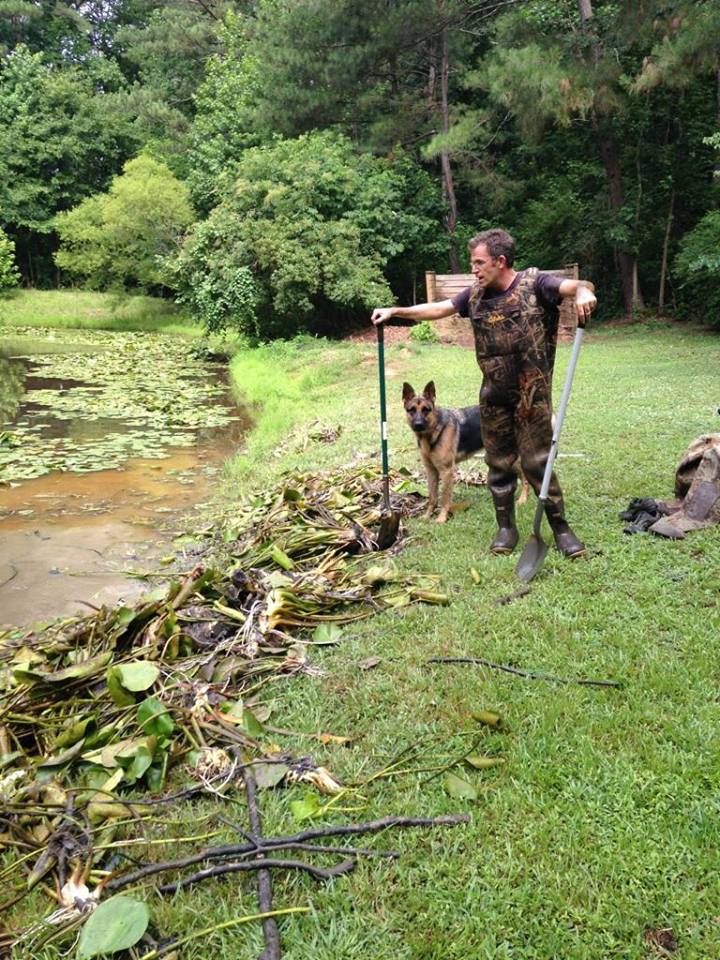Tired of doing this every month and a half:

I've looked at weed razors, weed gators, herbicides... actually had some limited success with triclopr, but I find it doesn't "finish them off."
Would love to hear a success story, or two.
Thanks,
Mark
Those are maybe spatterdock aka cow lily?? Do you have a picture of the flowers? Try treating mid to late summer when plants are actively storing 'food' products into the rhizomes. Best chemical control is using one of these herbicides: glyphosate, triclopyr, imazamox or 2-4D. Common glyphosate compounds are Rodeo, Aquamaster, Eraser AQ, Touchdown Pro, and Shore Klear Plus. Renovate 3 is a triclopyr compound and Clearcast is an imazamox compound. Since you have tried triclophyr with limited success and if you have some remaining try treating later in the season and mixed a little stronger. I have had success and prefer the glysophate products with aquatic approved surfactant(adjuvant) mixed a little on the strong side of the recommended dosage. Keep us updated on your progress so others can learn. First lets find out what they are specifically by seeing a flower picture.
If that is spatterdock I had an old pond that I refurbished that was nearly covered in it.
I was amazed when the dozer started pushing the muck out of the bottom of the pond how big the rhizomes of this plant get. Some were nearly as big as my arm and several feet long down into the muck. I had rhizomes laying all over the bank. Many tried re-sprouting even after laying in the sun for weeks and seemingly dried out.
My point is, with the nutrients stored in these rhizomes, it would take removal of the tops many, many, many times before the root could possibly be starved out to the point it could no longer send up new shoots.
So in my estimate, the only real way to get rid of the stuff would be with a systemic herbicide like Bill Cody suggests to go after the rhizomes in the bottom of the pond.
After seeing what grows beneath the surface, cutting the tops off to try and get rid of it looks like it would be an exercise in futility to me. Only other alternative is do like I did, drain the pond and clean all the muck and rhizomes completely out.
Here's the flower. Sorry it's not very good. The flower in question is small and yellow, and doesn't bloom big:

And the root? Good Lord:

Thanks for the help!
Mark
That is Spatterdock. A gallon will make about 75 gallons the way I mix it and would last you a long time. The really easy way to apply it is to get a 15 gallon electric sprayer for about $60 at the farm box stores and fasten it to your yard mower or pull it in a yard trailer.

I'm one of the few that likes Spatterdock as I use it as a backdrop in my photography.

So I got a 2 1/2 gallon jug of Rodeo at Tractor Supply for $80. Seemed like a pretty good deal at the time, as I was sure they wouldn't carry it.
I am going to spray an area Tuesday, and will take a bunch of photos.
Make sure you use the proper surfactant with the Rodeo or your results will be less than optimum. Cidekick II is a commonly used aquatic surfactant. Make the mixture on the strong side of the recommended dosage which usually has a low and high suggested rate. Please keep us advised as to your progress so others can benefit. As with many herbicides timing and proper application are important to success.
Rodeo Label wants the non-ionic surfactant to be 80% active ingredient. Normal concentration range is 1 oz (0.7%) to 2 oz 1.5% of Rodeo per gallon of spray. I would use at least 2 oz per gallon for spatterdock after they have flowered or at end of flowering. Retreat remaining green leaves after 3 weeks.
Label:
http://www.domyownpestcontrol.com/msds/Rodeo%20Herbicide%20(2.5%20gal)%20Specimen%20Label.pdf
CideKick II
http://pentairaes.com/cide-kick-ii-surfactant.html
Sorry I don't have pictures for you, but the rodeo is working at about 3 oz per gallon with surfactant.
Bill Cody is right on the three week thing. The leaves yellow, then fall off, leaving the stem. Then, sooner or later the stems start falling. It's a fairly slow process.
But, I think, with a schedule, one weekend day per month, I can get em all knocked out eventually.
My neighbor is on board. He say he hasn't seen this much spatterdock in any previous year. Looks like I'm green-lighted to treat the entire pond.
UPG, pretty soon ya should have the roots start poppin up to surface. Be prepared, they are heavy.
Urban - That is great news about success with spatterdock. Be diligent and you will have long term success.
Bob - the other morning, before coffee, I looked down there and thought, "Is that a dead beaver on the shore?"
Urban guy, I bet everyone who viewed this post felt bad for you. The first picture is worth a thousand words. Your dog looked many times happier than you. Good thing is now ya know there is a better way. Next spring if ya keep the new sprouting pads from reaching the surface they will die.
As for the Beaver root, I like that. Earlier this summer I helped my son eradicate lots of pads. Couple of weeks later he started to hand pick the roots out. He asked if all aquatic plants had roots made of lead.





